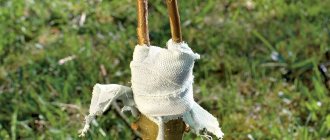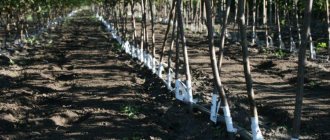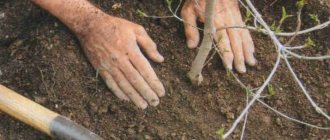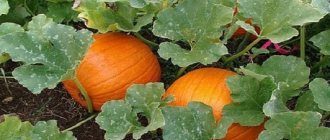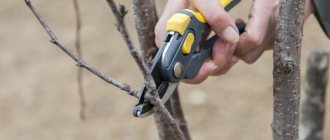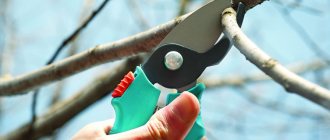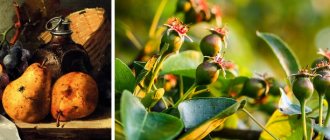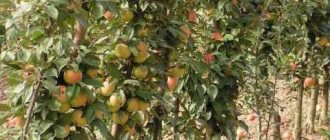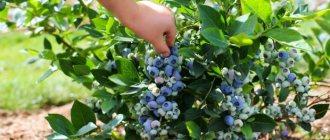Planting cherries in the Moscow region
Since cherries are considered a southern plant, the most important task is to provide the trees with sufficient lighting, protect them from the north wind and create comfortable humidity for the root system. Therefore, planting cherries in the Moscow region is most often done on the south side of a fence or building. You should also avoid shading the crown by planting other trees at a sufficient distance.
When to plant cherries?
If you buy seedlings with a closed root system, you can plant such specimens in open ground at any time. Sweet cherries prefer neutral soil, so garden soil that does not require alkalization or oxidation is quite suitable for planting. If you have planting material with an open root system, it is better to plant in the spring, in a planting hole already prepared in the fall with nutritious soil.
Cherry: main diseases of the crop
Sweet cherries have fewer diseases than other stone fruits, but the main diseases of the crop are coccomycosis and sweet cherry moniliosis.
Moniliosis occurs when plants are infected with pathogenic fungi Monilla cinerea. When the disease spreads on a cherry tree, the branches and leaves dry out, as well as the fruits rot. The infection quickly spreads throughout the tree crown, especially with dense plantings in low and damp places. Cool weather and frequent precipitation contribute to the disease.
Treat your garden against pests
Coccomycosis - infection with the fungus Coccomyces hiemalis appears on leaf blades in the form of merging spots of small red dots. The infection affects plants during inclement weather. The leaves become infected and gradually turn brown and fall off.
To combat infections, plants are treated with Horus at the rate of 30 g per bucket of water.
Advice! Soap should be added to the drug solution to form a thick foam. Spraying begins from the inside of the leaves.
Affected parts of diseased plants should be burned to prevent the spread of infections.
Of all the pests, the most harmful to cherries is aphids; pest control is carried out using special preparations.
Why don’t cherries bear fruit and what to do about it?
The cherry tree begins to bear fruit 4-5 years after planting. It happens that seedlings do not bear fruit - what could be the reason?
There are several factors why cherries do not bear fruit:
— pests
Aphids, leaf beetles and other insects can greatly harm the plant and cause crop loss.
— unsuitable soil.
Cherry prefers neutral fertile soil.
— bad location.
As we have already said, the plant needs a sunny area protected from the wind.
— pruning
Too thick a crown is not typical for cherries - it is very important to prune the seedlings in a timely manner.
— diseases.
Fungal, bacterial, and viral diseases can also ruin your harvests.
— lack of fertilizing.
For abundant and high-quality fruiting, you need to apply fertilizers rich in microelements at least twice a year.
— lack of pollinator.
Perhaps the variety you planted is self-sterile. Such cherries require cross-pollination.
Let's look at the last point in more detail. After all, when the cherry tree is healthy, not damaged, blooms beautifully, but still does not bear fruit, the lack of a pollinator is the most common reason. There are self-fertile, partially self-fertile and self-sterile varieties of cherries. The first category includes varieties that do not need additional pollination; representatives of the second category can bear fruit alone, but the harvests will be rare and meager; varieties from the third category are not able to bear fruit without pollinating neighbors. If in the first case even one tree will delight you with high-quality harvests, then in the other cases it is necessary to plant several varieties of cherries on the plot at once.
Varieties for the Moscow region
The climate of the Moscow region is determined by the geographical location of the region - the center of the East European Plain, where huge masses of warm and cold air move freely. Weather instability, when severe frosts give way to thaws, frequent spring frosts, and in summer either sweltering heat or prolonged bad weather, has an impact on agriculture.
Information! When growing heat-loving crops, there is always a risk of freezing even under cover, so you need to plant zoned varieties of fruit trees, bred specifically for this area.
The result of the work of breeders is frost-resistant, productive cherry varieties for the variable climate of the Moscow region. According to reviews from gardeners, the following are the most popular:
- Bryanochka. The height of the tree is no more than 4 m, the crown is sparse, well ventilated, fruiting occurs in 3-4 years. The fruits (diameter 2 cm, weight from 4 to 7 g) with red juicy sweet dense pulp ripen in late July-early August, are well stored, and are suitable for harvesting. The bone is small and comes off easily. Productivity from one tree is up to 50 kg. It is resistant to temperature changes and can withstand frosts down to -30 °C. Immunity to fungal infections is high. Pollinating neighbors are needed - the variety is self-sterile.
- Chermashnaya. Early ripening variety - fruits ripen by the end of June, tolerates wintering well, is resistant to fungal infections, pollination is required. The height of the tree reaches 4-5 m and begins to bear fruit after 3-4 years. The productivity of an adult tree is up to 30 kg. The fruits are yellow in color, medium in size, sweet and sour, the flesh is dense, juicy, the stone is easily separated.
- Fatezh. A self-sterile early variety with a tall (up to 3.5 m) tree, it begins to bear fruit in 4-5 years. The fruits are yellow-pink, large (up to 6 g), sweet, with a slight sourness, the flesh is dense, the stone is oval, and comes off easily. Ripening begins at the end of June. The yield of an adult tree is up to 50 kg of berries. Excellent frost resistance, tolerates drought and temperature changes well.
- Teremoshka. The trees grow no higher than 2.5 m, fruiting occurs in the 4th year of life, fruit ripening begins in the second decade of July. The fruit on a short stalk is large (5 - 6.5 g), the flesh is dark red, juicy, sweet. Resistance to frost and drought is average.
- Tyutchevka. Self-sterile, frost-resistant variety (withstands frost down to -25 ° C), tree height is from 4 to 4.5 m, the crown is spreading, fruiting occurs in the 5th year of life. The beginning of ripening occurs in the first ten days of July, full ripening occurs in August. The fruits are large (up to 7 g), dense, the flesh is dark red, sweet, juicy, the stone is difficult to separate. The maximum yield is 40 kg per tree. Frost resistance is good, spring frosts are not terrible - flowering occurs late, drought is poorly tolerated.
- Sinyavskaya. Trees with medium foliage, spreading, height – up to 5 m, ripening – 2nd decade of July, high resistance to frost. The fruits are red-yellow in color, weight up to 4.6 g, the color of the cartilaginous dense pulp is pink, the taste is sweet and sour. Up to 50 kg of berries are collected from one tree.
Self-sterile varieties of cherries that do not bear fruit without the help of pollen from neighboring trees and bees:
— Odrinka
— Gift to Stepanov
— Regina
— Fatezh
If your cherry blossoms but still does not bear fruit, you may have purchased a self-sterile variety. In this case, the right decision would be to purchase one or more cherries for your garden. The more varieties you have, the more harvest you will have.
It is not so difficult to choose a pollinator for cherries. You just need to plant a variety nearby that blooms at the same time as your tree. And the bees and the wind will help pollinate the cherries.
Collection and storage of fruits
The fruits are picked after acquiring the dark color characteristic of the variety. Unripe berries are not picked. They have an unpleasant, sour taste. It is impossible to ripen berries at home. Overripe berries fall off. They are eaten by birds, rot and attract insects. The fruits are picked in the morning after the dew has dried. If it rained the day before, picking the berries is postponed until they dry out. Otherwise, the fruits are poorly stored.
Ripe cherries do not last long. At room temperature, it remains fresh for no longer than seven days. In the cold, storage duration increases to three weeks if the fruits are completely dry. To preserve the berries for the winter, they are frozen. Before putting them in the freezer, they are thoroughly washed and dried. Then the berries are placed in a container and sent for freezing. Thawed cherries are used to prepare fillings for pies, sauces, compotes and other dishes.
Cherry care
In order for your cherries to feel good, delight you with their decorative appearance and bear tasty fruits, you need to take a responsible approach not only to planting the seedling, but also to its further care. What does a tree need for successful growth and development? Timely watering, pruning, periodic feeding, prevention from diseases and pests.
Cherry pruning
Timely pruning of cherries:
- increases tree productivity
- Helps develop immunity to temperature changes
– reduces the risk of diseases and pests
- promotes proper crown formation.
Formative and sanitary pruning of cherries, like all stone fruits, is carried out in the spring before the sap flows and the buds begin to swell (usually from mid-March to the first week of April).
General pruning recommendations:
- Before pruning, we inspect the tree. We identify dimly lit and poorly ventilated places inside the crown, remove diseased and poorly developed shoots. If the branches cross, cut off the weaker branch.
— it is necessary to cut off the cherry branches at the base, in the middle of the ring influx.
— stumps should not be left, as over time they begin to rot and the tree may soon die.
- a heavy and thick branch can be cut in several stages, sawing off the main part of the tree and removing the remaining stump.
- After pruning, it is necessary to disinfect the sections.
Watering, fertilizing, prevention of diseases and pests
Cherry requires, although not abundant, regular watering, since it is a moisture-loving plant. For rapid growth and development, the tree is watered in the spring - after wintering and before fruiting. If the summer is dry, watering should be increased, but not more than once a week. During fruiting, watering is stopped to prevent the fruits from cracking. It is very important to moisten the root system abundantly before wintering in order to increase the resistance of the cherry to frost.
Cherries are usually fed twice a season. In the spring, nitrogen-containing fertilizers are applied to speed up the recovery of the seedling after winter, and in the fall, mainly phosphorus-potassium fertilizers are applied.
Preventative treatment of plants against diseases and pests is carried out in the spring before buds open. You will find detailed information and recommendations for treatments in our article “Preparations for spring and autumn treatment of plants.”
At other times, spraying of cherries is carried out only after detection of a specific disease or pest. Also, to increase the resistance of a young seedling to unfavorable climatic conditions, it can be sprayed with bioregulators, for example, Epin or Zircon.
Cherries are not only tasty, but also a healthy fruit crop that should be in every garden.
The pulp of the fruit contains about 10% sugars, fiber, various organic acids, vitamins B, PP, C, essential oils, iron salts and a host of other substances that are incredibly beneficial for the body. By following the above rules for planting and further caring for seedlings, even a novice gardener will not have any difficulties in growing this wonderful crop.
Infections and pests
Stone fruit infections are caused by spores of various fungi, the growth and development of which is influenced by many factors: unfavorable weather conditions, infected neighboring plants, untreated soil (pathogens persist in it for a long time), contaminated tools, and uncleaned plant debris.
Diseases and pests dangerous to cherries:
- Red-brown spotting (coccomycosis). Small brown-red spots first appear on the top of the leaves, then they merge, compaction appears, a pink coating is visible on the underside of the leaf, the leaf turns yellow and falls off. In the spring, before flowering, they are treated with a solution of iron sulfate (300 g/10 l), after flowering, the diseased tree is sprayed with Horus solution (2 g/10 l), after 20-21 days the drug is re-treated, if the method does not help, then 20 days after harvest, use Horus again.
- The Monilia fungus (moniliosis) affects the entire plant: the shoots become deformed after dark spots appear on them, the leaves curl, gum is released, and the fruits gradually dry out. It is necessary to remove all affected parts, treat with a fungicide with copper, repeat three times with an interval of 1.5-2 weeks.
- White rust - its spores are carried by the wind, so the tree quickly loses its foliage, on which red swellings appear. Before flowering, spray with a solution of copper oxychloride (80 g/10 l), after harvesting the fruits - with Bordeaux mixture.
- The cherry weevil spends the winter in the soil and uses flowers, ovaries, leaves, and fruits for food, reducing the quality and quantity of the harvest. A small amount of the pest can be destroyed by simply shaking it off and placing a film under the crown. Repeat regularly until destroyed. Prevention - spray with Fufanon, Actellik before flowering.
- Cherry fly - dangerous larvae that suck juices from fruits and lay eggs in the pulp. Treatment with Karbofos no later than three weeks before picking berries will help.
- Cherry aphid - sucks the juice from the leaves, causing it to curl and the branches to become deformed. Treatment with Inta-Vir, Kemifos is required.
Preparing for landing
Planting a cherry seedling is a responsible task that should not be rushed. One mistake is enough for the tree to die or not produce a harvest. The gardener must take into account everything - from the proximity of fruit trees to the composition of the soil. Before you bury the planting material in the soil, you have to choose a place, prepare it and the seedling for planting.
Selecting a location
Landing site requirements:
- Good lighting. The site is chosen on a southern or south-eastern slope so that it is well heated by the sun.
- Protection from northern winds.
- Low groundwater level. If the waters lie at a level of 1.5 m from the ground level, the tree dies due to gum disease.
Cherries are never planted in lowlands.
Soil preparation
In arid areas, cherries grow best on fertile loam. In regions with fairly high humidity - on sandy loams. Clay, peaty and sandy soils are not suitable for cherries. Suitable acidity is pH 6.7-7.1. If a seedling is planted in black soil rich in humus, then a pH level of 8.0 is acceptable.
The soil for planting a seedling should be:
- airtight;
- moderately humid;
- weakly acidic.
When planting in spring, the land is prepared in the fall - it is dug up and fertilizers are applied. In the fall, most gardeners also prepare planting holes.
If the soil does not meet the requirements for planting cherries, it is improved by adding sand to clay soils, and clay to sandy soils.
To provide the cherries with nutrients, a mixture of soil and fertilizers is added to the planting hole; it is prepared from:
- topsoil – 2 parts;
- humus - 1 part;
- peat – 1 part;
- potassium sulphide – 50 g;
- superphosphate – 100 g.
The components are mixed, and 10 days before planting the seedling, the hole is filled 1/3 with the resulting mixture.
Do not apply nitrogen fertilizers when planting cherry seedlings - they can burn the roots.
What should the hole be like?
When a place for planting has been chosen, they begin to dig a hole. In this case, the fertile layer is deposited separately from the extracted soil. If there is spring planting ahead, you need to prepare the hole for planting no less than 2 weeks in advance. Recommended pit dimensions:
- depth – 70 cm;
- width – 80-100 cm.
The dug hole should not have any narrowing of the walls. When planting several seedlings, a gap of 2 m or more is left between adjacent holes.
Seedling
Its further development depends on the correct preparation of the seedling for planting. Preparation procedure:
- 24 hours before planting, the seedling is immersed in a bucket of water to activate the root system.
- Before planting, cut off damaged roots, if any.
- Long roots are trimmed so that the root system fits completely in the planting hole.
- All leaves are removed so that the seedling does not lose moisture.
Pros and cons of spring planting
Planting cherries in spring has its advantages and disadvantages compared to autumn.
Pros of spring planting:
- In 6 warm months, the seedling will be able to grow stronger and grow a root system before winter, thanks to which it will be able to survive until next year.
- During the season, you can observe the development of cherries and take timely measures in the event of a disease or pest attack.
- In the fall, you can prepare a planting hole, which will settle by spring. This way the seedling will be planted correctly and the root collar will not be too deep.
Along with the advantages, there are also disadvantages of planting cherries in the spring:
- In the spring, the seedling begins an active growing season, so it needs a lot of effort to build up green mass and take root.
- The gardener has a lot of work at this time and cannot pay full attention to all the trees.
Important! Cherry is a heat-loving tree, so when planted in the fall, it can freeze in the winter, since it will not have time to take root before frost arrives.
Watch the video ! Cherry planting and initial pruning. Tips for buying cherries
Where to plant cherries on the site
To plant cherries, you will need a well-lit and ventilated place. At the same time, it must have protection from cold northern winds in the form of dense trees, walls of buildings or structures, and fences. It is better to choose a small southern or southwestern slope where water will not stagnate. Swampiness and close occurrence of groundwater (less than 2.5 meters) are not allowed.
What kind of soil does cherry tree like?
For cherries grown in arid regions, fertile loams are suitable, and in areas with sufficient or excessive moisture - sandy loams. In this case, the soil should have a loose, well-drained structure. The optimal acidity level is pH 6.7-7.1, but on chernozems with a large amount of humus, plants can also tolerate carbonate content (increased alkaline reaction) of the soil. In this case, reaction up to pH 8.0 is acceptable.
How to plant cherries if groundwater is close
There is no economically feasible way to grow cherries in areas with close groundwater. On wet soils, it is necessary to carry out drainage by constructing drainage ditches that remove excess moisture outside the site. This pleasure is not cheap and labor-intensive.
Draining a site is an expensive undertaking.
In cases where the groundwater level is within 1-1.5 m, you can plant cherries on a hill. It is poured over a planting hole 0.5-1.2 meters high and 2-2.5 meters in diameter.
At what distance should cherries be planted from each other?
The planting interval depends solely on the size of the crown. And it, in turn, depends on the cherry variety and the rootstock on which the grafting was carried out. On average, the diameter of the cherry crown is usually 2.5-4 meters. Based on the characteristics of the planted variety, the distance between trees in a row is taken equal to the diameter of the crown, and the distance between rows is increased by 1-1.5 meters. That is, with a crown diameter of 3 meters, the planting pattern is 3 x 4 meters.
Cherries are planted at a distance of three meters from each other
What trees can you plant cherries with?
It is best to group plants according to the principle - like with like. It is preferable to plant cherries in a group with other cherries and cherries. Pome fruits - apple and pear - usually inhibit cherries, so you should stay away from them. You should also avoid proximity to sea buckthorn - in general, it is a bad neighbor for any crops. Apricot has a fairly extensive and powerful root system, which will actively fight with the same powerful root system of cherries. Therefore, it is worth spreading their proximity by 5-6 meters. Plum and cherry plum will not harm the cherry, but it itself will oppress them.
Where to plant self-sterile cherries
Self-sterile cherry varieties require the presence of pollinating plants within a radius of 50-100 meters. As a rule, these should be cherries of other varieties, the flowering period of which coincides with the flowering period of the planted tree. In addition, according to information from some sources, the Lyubskaya cherry variety is a good pollinator for cherries. This should be taken into account when planting cherries. If there are no such plants nearby, but you want to plant cherries, especially self-sterile ones, then you will have to simultaneously plant cherries of a pollinating variety.
Ripening time and characteristics
- The early ones ripen by the end of the first summer month.
These include Iput, Skazka, Chance, Cheremashnaya, and Homestead Yellow. Leningradskaya black - Mid-ripening ones will bear fruit by mid-July - Tyutchevka, beloved by many Rechitsa, Fatezh, Poetry and Orlovskaya pink.
- The later ones will give a harvest by the beginning of August - Leningradskaya black, Orion, Prestige, Bryansk pink.
We invite you to read: Rules for caring for strawberries after harvest
Most of the varieties grown are tall. Only some species are characterized by moderate growth, for example, the Fatezh variety. Small trees are easier to care for and are ideal for small planting areas. Low-growing varieties are the work of breeders. Plantings can be placed next to warm beds or near a gazebo.
The fruits are also distinguished by color:
- Black or dark red - Announcement, Revna, Annushka, Ovstuzhenka, Rechitsa, Valery Chkalov.
- Pink - Aelita, Early pink, Orlovskaya and Leningradskaya pink.
- Yellow – Cheremashnaya, Drogana and Homestead yellow.
- Orange – Pink pearl.
Birds love to peck red berries; yellow fruits are more resistant to such guests. Red fruits are more susceptible to cracking. The taste of the cherry fruit is sweet and sour. Sweet varieties include Ovstuzhenka, Tyutchevka, Michurinskaya, Rechitsa, Ariadna, and sweet-sour varieties - Poeziya, Fatezh.
The best cherries are those that bear a lot of fruit. On this basis, the following varieties should be distinguished: Drogana yellow, Priusadnaya yellow, Revna, Iput, Fatezh, Bryansk pink. The average number of fruits is in Rechitsa, Leningradskaya black and pink, Tyutchevka. Ovstuzhenka has low yields. If you have decided on the variety and landscaped the garden, then you can take care of arranging fences for the beds. For this purpose, not only specialized materials are used, but also slate and boards left over after construction.
Video with an overview of varieties.
Chemical treatment and pruning of bush cherries
Bush cherries: pruning
Since bush cherries bear fruit on one-year-old branches, pruning should be carried out regularly and in a timely manner, otherwise the yield of the crop will be significantly reduced and the berries will be crushed.
Trimming
- remove damaged and dry branches;
- cut off excess root shoots and branches older than 7 years (under the ring);
- Leave on the bush: 10-15 shoots with the largest number of lateral branches and 3-4 basal shoots.
Spraying
During the flowering period, cherry bushes are treated to prevent fungal and bacterial diseases with the following preparations: urea (diluted in the proportion of 700 g per 10 liters of water), copper sulfate (300 g per 10 liters).
Complex protection products Agravertin, Fitoverm, Zircon, Ecoberin, Fitosporin are considered no less effective. To prepare the latter, it is enough to dissolve 200 g of powder in 400 g of water (1:2), and then dilute 1 tbsp. l of solution in 10 l of water. After flowering, the bushes are treated again 2-3 times every 7-10 days.
Result:
Bush cherry is an unpretentious plant. But in order to annually obtain a high-quality harvest, it is necessary to regularly carry out a set of measures to care for, pruning and protecting trees from pests and diseases.
vsadu.ru
Cherry replanting in spring
Transplanting a cherry tree is an undesirable event for it. Moreover, the older the plant, the more harmful the consequences can be and the higher the risk of failure to survive. This is due to the inevitable injury to the root system, as well as the loss of most of it in the event of replanting an old tree.
When can you replant cherries in spring or autumn?
Most gardeners recommend doing this in early spring, especially in cold climates. This is explained by the fact that, having been transplanted in the fall, the tree will not have time to take root well and will go into winter weakened. In places with mild winters and hot summers, it is recommended to replant in the fall, since the plant here has a greater chance of drying out in the summer than freezing out in the winter. In any case, when preparing for replanting, it is better to rely on the experience of local gardeners and specialists.
How to replant young cherries, including three-year-old ones
Transplanting young cherries is not much different from planting a seedling. The main difference is that in order to transplant a tree, it still needs to be dug out of the ground correctly.
Step-by-step instructions for transplanting young cherries
In this instruction we will describe the process of spring planting of a transplanted tree:
- First of all, the young tree needs to be dug out of the ground. This is done in the fall, since in the spring weather conditions may not allow digging up the plant before the sap begins to flow. To do this: If the soil is dry, then the day before digging it should be watered to soften it.
- A circle is drawn around the tree with a diameter equal to the expected diameter of the root system. You can do this with a string tied to the trunk and some kind of stick.
- Using a shovel, dig a groove around the plant, focusing on the drawn circle.
To replant, dig a groove around the plant, focusing on the drawn circle.
- Remove the plant from the hole, being careful not to destroy the earthen lump on the roots.
- They dig it in the garden for winter storage.
How to replant an adult cherry tree
If necessary, an adult tree can also be replanted, although experts believe that cherries over seven years old will not tolerate this. In this case, you can try an interesting method, which is as follows:
- At the end of September, a circle is marked around the tree, as in the case of a young tree. Its diameter should be such as to capture as many roots as possible, but at the same time, the weight of the extracted part should be within reasonable limits.
- Using a sharp shovel with a flat blade, cut the roots halfway around the marked circle.
- Dig a trench along this half of the circle with a depth of a shovel bayonet.
- In the lower part of the trench, the roots are cut even deeper, onto the bayonet of a shovel.
- Fill the trench and water it with water.
- The tree continues to feed from the second half of the roots that remain intact. During the first half, at this time, new roots will begin to form, which will fill the internal space of the root system.
- After 3-4 weeks, the same procedure is carried out with the second half of the roots. They are cut, dug in, cut again, buried. Water generously for another two weeks and leave the tree until spring.
- At the same time, it is worth taking care of the planting hole for the transplanted plant.
- In early spring, as soon as the weather permits, the plant is dug out of the ground with a clump of young roots and transplanted to a new location.
Unfortunately, there are no illustrations of this method, but there is an excellent video that is worth watching.

